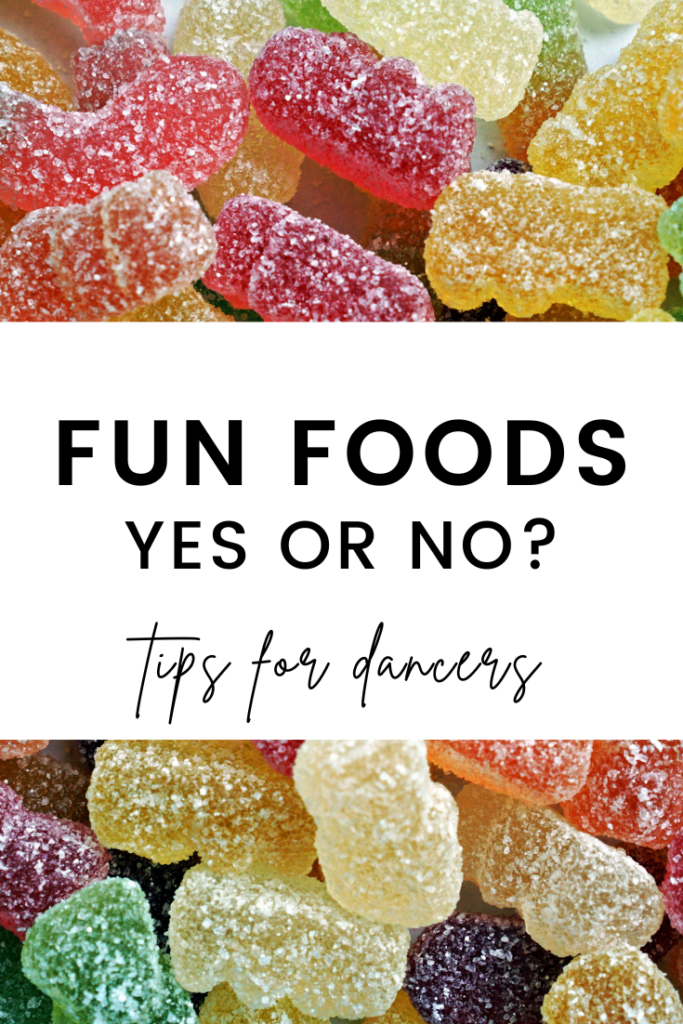Restrictive dieting behaviors, whether obvious (like calorie counting) or subtle (like “clean” eating) strip the fun from food― turning eating experiences into math equations riddled with angst and guilt. As discussed in this article, however, even “fun foods” that are technically considered to be less nutrient-dense can (and should) be included in your dance fueling plan.
What are “fun foods?”
As part of the intuitive eating paradigm, the term “fun foods” is utilized when describing options that, when compared to other foods, are less nutrient-dense The most obvious examples of “fun foods” are sweets and desserts, but for dancers who are recovering from disordered eating patterns and “clean”-eating lifestyles, “fun foods” might also include fast food and processed food.
This term is not meant to assume that nutrient-dense foods are not fun. There are countless ways to experiment with food and flavors― arguably, all foods can be fun! Ultimately, this is the goal. But for those struggling with disordered eating or a diagnosed eating disorder, most food- whether nutrient-dense or not, feels anything but fun (or safe).
So, are fun foods just “unhealthy” foods?
Though it can feel like an alternative term for “bad foods” or “junk food,” the term “fun foods” is only a tool to be used temporarily while healing from diet (and wellness) culture. Descriptors like “bad,” “unhealthy,” or “junk” imply disgust and wrongful doing, exacerbating food fears and distrust between you and those foods. For many dancers, viewing these foods through a more positive lens will offer a helpful step in your work towards regaining the ability to include these foods without overwhelming guilt. This is especially true for dancers who are just starting to rebuild their relationships with food. Letting go of descriptions like “bad,” “unhealthy,” and “junk” is often challenging, so utilizing “fun” helps.
We’re not relabeling “bad foods,” “junk foods,” or “unhealthy foods” with the term “fun foods.” Rather, the term “fun foods” is just a temporary tool that helps to reignite the potential for joy around those otherwised feared foods. This can be a critical step in your journey towards healing from diet and wellness culture.
How often can I eat “fun foods”
I teach dancers how to utilize an intuitive approach for performance― not only are we prioritizing balance and consistent fueling, but we’re also uncovering key tools to assist in the process of gaining self-trust around all foods. These tools include:
- Unconditional permission (learn more here)
- A food-neutral lens
- Mindful eating techniques
- The hunger and fullness scale
- The Healthy Dancer® Food Flexibility algorithm
Utilizing these tools will help your ability to rely on intuitive cues of fullness, rather than on external tools like calorie counts and those designed to dictate how much to eat.
In my experience working with dancers for over a decade, incorporating “fun foods” is a daily necessity. This eventually leads to food habituation (a topic I discuss here). In other words, foods are removed from a supposed pedestal― no longer do you feel a sense of distrust around them. Rather than needing to “get it in now because tomorrow is a restart,” you feel at ease knowing those foods are just one choice among a variety of foods. With practice, this mindset of permission crowds out the mindset of scarcity, allowing you to then apply nutrition knowledge more gently (learn more here). Christy Harrison, a fellow dietitian and author, does a fabulous job at educating on these concepts― I encourage you to support her work here.
I’m struggling to understand the benefits of “fun foods”
Remember: food is meant to nourish your body and your soul. Satisfaction is the fourth macronutrient on our balanced plates. Also, “fun foods” can serve functions beyond just being “fun” additions to your day. Sweets and other sources of simple carbohydrates offer our bodies easily accessible energy, which is exactly what you need to get through the final 15-30 minutes of an exhausting rehearsal or performance. Depending on food accessibility (more on this below), fast food will provide your body with the nourishment and calories it needs to navigate the world.
This is also why I encourage dancers to reclaim what it means to be an emotional eater. Diet culture imposes the belief that turning to food to cope with emotions is wrong. While food isn’t designed to help long-term emotional distress, it can offer short-term support in a way that is not harmful. Making space for the joy of food is critical.
What if I eat too much?
The intuitive eating approach does not place upper limits on “fun” foods. When we fixate on the perceived wrongdoing of “over”-eating these foods, we drive ourselves further from that ability to stop eating when feeling full. Here’s an article to learn more about this.



